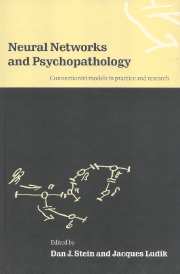Book contents
- Frontmatter
- Contents
- List of contributors
- Preface
- Part one General Concepts
- 1 Neural networks and psychopathology: an introduction
- 2 The history of neural network research in psychopathology
- 3 Neural network models in psychiatric diagnosis and symptom recognition
- 4 Neural networks and psychopharmacology
- 5 A connectionist view of psychotherapy
- 6 Modulatory mechanisms in mental disorders
- Part two Clinical disorders
- Epilogue
- Index
5 - A connectionist view of psychotherapy
from Part one - General Concepts
Published online by Cambridge University Press: 12 January 2010
- Frontmatter
- Contents
- List of contributors
- Preface
- Part one General Concepts
- 1 Neural networks and psychopathology: an introduction
- 2 The history of neural network research in psychopathology
- 3 Neural network models in psychiatric diagnosis and symptom recognition
- 4 Neural networks and psychopharmacology
- 5 A connectionist view of psychotherapy
- 6 Modulatory mechanisms in mental disorders
- Part two Clinical disorders
- Epilogue
- Index
Summary
The state of the art in psychotherapy
Psychotherapy is the discipline of treating psychological (including somatoform) disorders with psychological means in a planned, professional way. Psychotherapy has made considerable progress since the days of unsystematic, although sometimes very effective, stimulation of psychological change by gifted and charismatic individuals. The elaboration of unconscious mechanisms by Freud, the formulation of learning mechanisms by the behaviourists, and the plea for the power of human relationship by Rogers, are just a few of the many steps in this development. A better understanding of the mechanisms underlying the development and maintenance of disorders, as well as the principles of change, has been achieved. More is known both about the effects of psychotherapeutic procedures and about the factors that are significant in the process of psychotherapy. Under the scrutiny of empirical data, some approaches, such as (cognitive) behaviour therapy, have experienced considerable change. Today, depending on the type of disorder, psychotherapy offers success rates of 70–85 per cent.
Studies of cost-effectiveness show that high-quality psychotherapy is such an excellent investment that the question is not whether society can afford psychotherapeutic services, but whether society can afford to renounce psychotherapy if the limited costs of psychotherapy are compared with the almost unlimited costs of untreated psychological problems (Grawe, Donati and Bernauer, 1998). Books such as the Handbook of Psychotherapy and Behavior Change (Bergin and Garfield, 1994) give testimony to the progress we have made and the position we have reached. Such books contain a wealth of knowledge, too extensive to be stored and handled by any one individual. We have reason to be proud of what we have achieved so far.
- Type
- Chapter
- Information
- Neural Networks and PsychopathologyConnectionist Models in Practice and Research, pp. 88 - 131Publisher: Cambridge University PressPrint publication year: 1998
- 8
- Cited by

